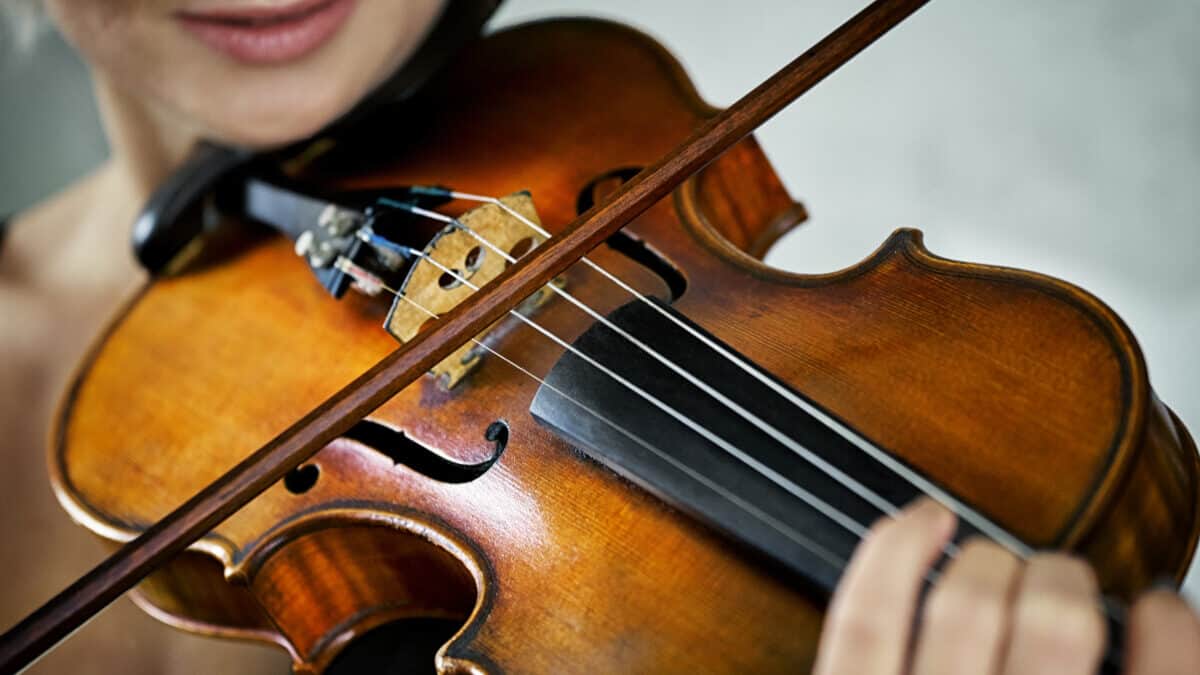
Many violinists use various bow techniques to produce the sound they desire. Tilting the bow on the strings is often one of those techniques.
Violinists tilt their violin bow to control the volume and weight of the bow. This allows violinists to keep an even sound and tone throughout the entire bow stroke. Most violinists consciously use it to manage the sound of the violin.
It’s not necessary to tilt your bow at all times, however. Instead, it would be best if you only tilted your bow depending on the sound you are trying to achieve.
Reasons Why Violinists Tilt Their Bow
There are various reasons why many violinists tilt their bow, but the most common reason is to control the volume and manage the bow’s weight.
Other reasons violinists tilt their bow are to play smoother at the frog, play softer, or simply because it feels more comfortable playing that way.
It’s more challenging to play at the frog than in the middle of the bow because it’s harder to manage the weight near the frog.
The weight on the bow should be distributed equally to keep an even sound throughout the bow stroke.
Most violin students find it challenging to play with an even sound throughout the bow stroke. This is one of the reasons why the violin is easily one of the challenging instruments to learn due to its complex nature.
Achieving a good sound on the violin is often one of the most challenging tasks for many violin students. That’s why it’s essential to properly understand how to bow on the violin.
When Should You Tilt Your Bow?

If you have difficulty controlling the volume on the violin or managing the weight on your bow, you might find it easier to control those things by tilting the bow as you play.
When you tilt the bow, you play with fewer hairs on the strings. The fewer hairs you play with, the softer the sound you will produce on the violin.
You want to produce an even sound as a violinist as you play. You do this by keeping a balanced weight throughout the entire bow stroke. However, sometimes you may find that the sounds you produce are scratchy or slightly off-tune.
One of the leading causes of this is that there may be too much pressure on the string, causing it to create undesired sounds. This is why many violinists tilt their bow while they play. i.e. To take some pressure off the strings.
If you have difficulty controlling the weight on the strings, you may find it easier to control the pressure by tilting your bow. More than likely, you will see an immediate difference.
You shouldn’t always play with a tilted bow, however. Playing with a tilted bow is just a technique to help you keep an even and beautiful sound as you play, not as an actual style of playing. So only tilt your bow when necessary!
Another thing to note is that there is more pressure closer to the frog than at the end of the bow, but why is there more pressure closer to the frog?
There are two reasons:
- More Material By The Frog
- Weight Of Your Arm
There’s a lot of material like the adjusting screw, winding, ferrule, and the frog itself that make it harder for you to control the weight of the bow. On top of that, the weight of your arm is harder to stabilize towards the frog.
Those issues shouldn’t be a major concern, though. As I mentioned, you should only tilt your bow when necessary. For you, it might be necessary to play with a tilted bow when you’re playing by the frog.
However, if you can keep an even sound through the entire bow stroke, it might not be necessary for you.
How To Tilt Your Bow
I don’t think it matters which way you tilt the bow as long as it feels comfortable to you.
Many teachers suggest that you tilt the bow towards the bridge, meaning that the hairs should face the bridge.
I often switch up how I tilt my bow according to how necessary I feel it is.
For example, when I’m at the frog, I feel more comfortable playing with the bow hairs facing the bridge, and when I’m just naturally playing, I find it easier to play in the other direction.
It’s a matter of finding your unique playing style and adjusting accordingly.
Make sure that you’re not causing any strain on your forearm when you’re playing. If you feel any tension, this could indicate that your form is off or that your arm is too tight.
Be sure that when tilting your bow, you’re doing it in a way that feels most comfortable!
Is It Better To Play Flat Or Tilted?
The best way to play is flat on the strings. Playing flat on the strings will help produce a stronger sound than if you were playing with a tilted bow.
All violinists should know how to play with a flat bow properly because it’s part of the basics. However, both styles of playing come with their advantages.
Playing with a tilted bow will help create a softer sound on the violin and allow you to control the volume, while playing flat on the strings will create a more powerful sound since all the bow hairs are hitting the strings.
Ultimately, it’s just a matter of experience and finding out what works best for you. For example, sometimes you may feel the need to play flat on the strings to play louder, while other times, you may feel the need to play tilted to play softer or to balance the weight on the bow.
As I mentioned, you should only play tilted when you feel necessary and not as an actual way of playing all the time. Both techniques are beneficial; only you will know when the best time to use each one is necessary. Find your playing style and adjust according to it!
